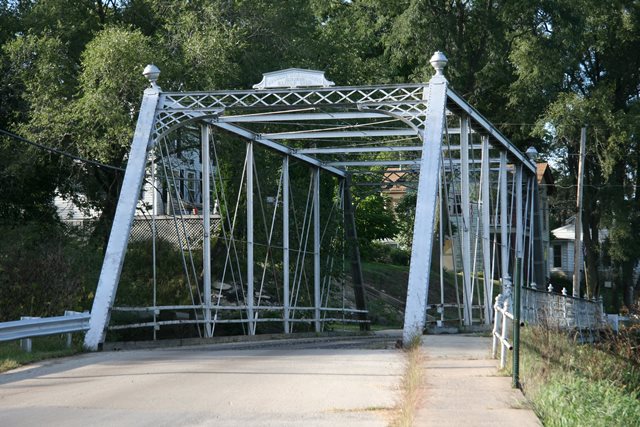We Recommend:
Bach Steel - Experts at historic truss bridge restoration.
Galena Street Bridge

Primary Photographer(s): Nathan Holth and Rick McOmber
Bridge Documented: September 4, 2010 and October 15, 2021
Mount Carroll: Carroll County, Illinois: United States
1890 By Builder/Contractor: Wrought Iron Bridge Company of Canton, Ohio
2017
97.0 Feet (29.6 Meters)
99.0 Feet (30.2 Meters)
16.7 Feet (5.09 Meters)
1 Main Span(s)
8610000000000

View Information About HSR Ratings
Bridge Documentation
Bypassed and preserved for pedestrian use, this outstanding example of an urban-built Wrought Iron Bridge Company truss bridge is one of the only truss bridges preserved in Illinois outside of Chicago. In general, Illinois (outside of Chicagoland) does not preserve its historic metal truss bridges. As such the preservation of this bridge is noteworthy as it is one of the only bridges of its kind in Illinois with a bright future. It is further rare as an urban pin-connected truss bridge. Most surviving pin-connected truss bridges are found in rural locations on quiet roads. With this urban bridge, details not found on rural bridges can be obseved like the presence of a sidewalk with ornate railings and decorative finials. Very few bridges surviving today retain decorative features like this.
An interesting detail on this bridge is that the verticals on the sidewalk side of the bridge have plate riveted to the rolled beams for added strength while the ones on the side without a sidewalk do not have the riveted plate.
It is also interesting to note the methods used in rehabilitating this historic bridge. Perhaps a side effect of so little preservation in Illinois, the bridge appears to have been rehabilitated by extremely nervous engineers who appear to have not trusted the design of the bridge. While the sidewalks and their beautiful railing have been retained, they are fenced off with cable railing. Pedestrians must walk in the the center (former vehicular traffic portion) of the deck as cable railings restrict the width of this portion of the bridge as well. These restrictions indicate that the engineers did not think the bridge could handle the targested pedestrian loading over the entire deck surface area, thus a restriction of areas where people can walk was needed. If the engineers who designed this rehab were following the (rather ridiculous) AASHTO guidelines for pedestrian loading (85-95psf loading range), this may actually be higher than with vehicular bridges with posted weight limits, as crazy as that sounds. Such loading assumes a bridge so densely packed with people that the only bridges in the United States ever so packed with people would be in major cities before the pandemic during major city events like fireworks shows over rivers, etc. However the rehab of this bridge according to the plans and the plaque indicates a design load of only 65psf which is very low. The bridge is in good condition. It seems hard to believe that the entire deck surface could not even handle 65psf. Anyway, this bridge is definitely capable of greater loads then the conservative deck layout suggests. Another unusual aspect is that the built-up fishbelly floorbeams (which include laced sidewalk cantilever brackets and Wrought Iron Bridge Company's unique star caps) look like replacements, but they are not. The original wrought iron floorbeams were totally disassembled, hot dip galvanized, and reassembled using modern bolts. This use of bolts instead of rivets make the floorbeams look like modern replacements when they are not. Had this project taken place in Michigan or Indiana these floorbeams would have been riveted back together and they would have looked identical to the original design.
View Archived National Bridge Inventory Report - Has Additional Details and Evaluation
This bridge is tagged with the following special condition(s): Unorganized Photos
![]()
Photo Galleries and Videos: Galena Street Bridge
Bridge Photo-Documentation
Original / Full Size PhotosA collection of overview and detail photos. This gallery offers photos in the highest available resolution and file size in a touch-friendly popup viewer.
Alternatively, Browse Without Using Viewer
![]()
Bridge Photo-Documentation
Mobile Optimized PhotosA collection of overview and detail photos. This gallery features data-friendly, fast-loading photos in a touch-friendly popup viewer.
Alternatively, Browse Without Using Viewer
![]()
Additional Pre-Rehab Unorganized Photos
Original / Full Size PhotosA supplemental collection of photos from 2010, before rehab, that are from additional visit(s) to the bridge and have not been organized or captioned. This gallery offers photos in the highest available resolution and file size in a touch-friendly popup viewer.
Alternatively, Browse Without Using Viewer
![]()
Additional Pre-Rehab Unorganized Photos
Mobile Optimized PhotosA supplemental collection of photos from 2010, before rehab, that are from additional visit(s) to the bridge and have not been organized or captioned. This gallery features data-friendly, fast-loading photos in a touch-friendly popup viewer.
Alternatively, Browse Without Using Viewer
![]()
Maps and Links: Galena Street Bridge
Coordinates (Latitude, Longitude):
Search For Additional Bridge Listings:
Bridgehunter.com: View listed bridges within 0.5 miles (0.8 kilometers) of this bridge.
Bridgehunter.com: View listed bridges within 10 miles (16 kilometers) of this bridge.
Additional Maps:
Google Streetview (If Available)
GeoHack (Additional Links and Coordinates)
Apple Maps (Via DuckDuckGo Search)
Apple Maps (Apple devices only)
Android: Open Location In Your Map or GPS App
Flickr Gallery (Find Nearby Photos)
Wikimedia Commons (Find Nearby Photos)
Directions Via Sygic For Android
Directions Via Sygic For iOS and Android Dolphin Browser
USGS National Map (United States Only)
Historical USGS Topo Maps (United States Only)
Historic Aerials (United States Only)
CalTopo Maps (United States Only)


